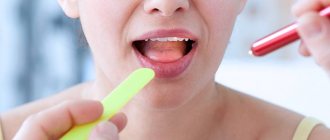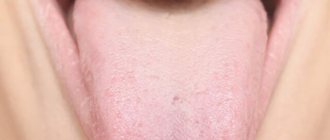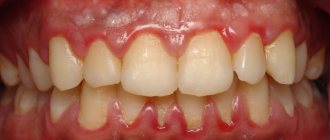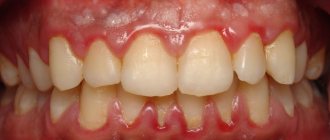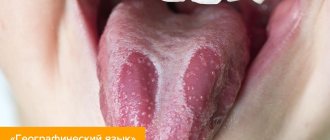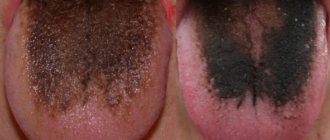Anatomical structure of the tongue
The structure of human language corresponds to its multifunctionality, which lies in the fact that it participates in the processes:
- chewing;
- salivation;
- taste perception;
- speech.
The body of the tongue consists of striated muscle tissue, which is covered by a membrane of mucous tissue. Its surface, called the back, is conventionally divided into three parts:
- the last third, located near the pharynx, is called the root;
- the first two thirds are the body of the tongue.
A longitudinal groove runs in the middle, which is an external manifestation of the internal septum; it is, in fact, a reduced thyroglossal duct.
The mucous membrane, tightly adjacent to the muscle tissue, is covered on the outside with stratified squamous epithelium. It contains:
- salivary glands;
- taste buds;
- lymphatic ducts.
The mucous membrane of the posterior part forms three supraglottic folds, with the help of which the tongue is attached to the larynx:
- median;
- two lateral.
The tongue is abundantly covered with papillae, including:
- filamentous - act as organs of touch and, thanks to the rough surface, hold food on the tongue;
- cone-shaped – responsible for sensitivity to temperature and pain;
- mushroom-shaped - equipped with taste buds, thanks to them we distinguish many taste sensations;
- groove-shaped - located near the root, have serous glands and are also responsible for the sense of taste;
- leaf-shaped - equipped with lingual glands that secrete a mucous secretion.
The tongue is attached to the oral cavity by a fold of mucous membrane called the frenulum.
Associated symptoms
White coating on the tongue is usually accompanied by the following symptoms:
- burning and dry mouth;
- increased thirst;
- increased body temperature;
- heartburn and belching;
- bad breath;
- muscle weakness and causeless fatigue;
- severe sore throat, aggravated by eating;
- craving for sweets (one of the signs of candidiasis);
- irritable bowel syndrome (diarrhea, pain, etc.) and bloating.
You should know! At the same time, some of the accompanying symptoms may be absent in certain cases (depending on the underlying disease - the root cause of the appearance of white plaque).
- White plaque in the throat: in children and adults. Causes and treatment
What does a healthy tongue look like?
A white-pink color of the tongue is considered normal. There are a number of other accompanying signs of his health:
- the longitudinal fold of the tongue is clearly visible;
- the papillae are clearly visible, but not hypertrophied;
- the edges are smooth.
The surface must be clean, although a slight coating on the tongue is acceptable.
For an adult, seasonal changes in the color of the tongue are possible:
- in winter, a slight yellowish coating on the tongue in adults can be considered normal if there are no other abnormalities - pain, increase in size, lack of taste;
- in summer, a light white coating, not localized, but over the entire surface, is also not considered a pathology.
A healthy child’s tongue is not much different from an adult’s tongue. One significant feature: it reacts to the slightest changes in the condition of the baby’s body - teething, the introduction of complementary foods, even a change in the brand of baby food. Therefore, plaque on a child’s tongue requires close attention.
What is plaque on the tongue?
The most numerous - filiform papillae - form a white coating on the tongue due to their structure:
- the lamina of the mucous membrane of the filiform papilla is covered with stratified squamous epithelium;
- this is a keratinizing epithelium that periodically exfoliates, covering the entire tongue with a light white coating;
- In case of any malfunctions in the human body, desquamation slows down and a layer of keratinized cells grows, which acquire different colors depending on what pathology led to the malfunction.
By the color of the plaque and where it is localized, diseases that have led to pathological changes in the tongue are judged.
Yellow plaque
A yellow coating on the tongue usually indicates digestive disorders. The following tips will help you:
- Carefully observe which foods cause a yellow coating on the tongue and eliminate them from your diet.
- Take Allohol tablets before meals to improve digestion.
- To normalize the functioning of the digestive system, take a decoction of flax seeds.
If the above measures do not help you, consult a gastroenterologist, he will tell you not only how to deal with plaque on the tongue, but also how to get rid of its root cause.
Why does plaque appear on the tongue?
The tongue is a muscular organ that can tell a lot about the state of the body. It is soft and easily mobile, and has a pale pink color if the person is healthy. From time to time, plaque may appear on the mucous membrane, the density of which is often seasonal. This is explained by the fact that at different times of the year the body needs certain vitamins. For example, in summer the deposits are thicker and more saturated. At this time they may acquire a yellow tint.
Bacteria constantly accumulate on the mucous membrane of the tongue. These microorganisms are the cause of plaque and bad breath.
The following factors contribute to their intensive reproduction:
- excessive alcohol consumption;
- smoking;
- poor nutrition;
- infections and inflammatory processes;
- taking medications;
- chronic diseases;
- poor oral hygiene.
Since the tip of the tongue is mobile, it is cleaned more and, accordingly, there is less plaque here. At the root, its density is higher, since in this place there is contact only with the sky. Such manifestations are also possible with dysbacteriosis, vitamin deficiency, and improper hygiene.
In what case should you consult a doctor and undergo an examination?
The following signs are reasons to consult a doctor:
- The presence of a dense, cheesy plaque , which is not removed when brushing the teeth and mouth or quickly appears again.
- Edema and swelling of the tongue.
- Bad breath .
- Pain and burning in the abdomen , eating disorders.
- Presence of small ulcers in the mouth .
- Rash on the face and body.
- Impaired taste sensitivity.
- Dryness and burning in the mouth.
- High body temperature.
- Constant weakness and lack of energy.
Remember! All of the above symptoms should be a cause for concern and immediate consultation with a doctor (ENT specialist, therapist, dentist or gastroenterologist).
Types of plaque on the tongue
White plaque
A thin white coating is a common occurrence. You can especially notice it in the morning, when your teeth have not yet been brushed. Homogeneous white deposits occur in infants after feeding. This is also considered normal in older children.
The presence of other features may indicate certain ailments:
- an increase in plaque thickness is a symptom of prolonged constipation;
- elevated temperature and symptoms of intoxication - indicate infectious processes in the body;
- localization on the root of the tongue, its back – gastrointestinal diseases;
- placement on the sides of the tip of the tongue - pay attention to the kidneys.
A white coating with a cheesy structure, as well as dry mouth, indicate candidiasis (popularly called thrush). It often affects infants. The cause of the disease is weak immunity. To prevent thrush from spreading to the cheeks and gums, you should consult a doctor. He will prescribe antifungal medications. This disease is also possible in older children, but more often these are asthmatics or children with weakened immune systems. The disease may be accompanied by an unpleasant taste in the mouth.
Gray, green and brown plaque
And if the deposits are not white, but of a different color - what is it? Each shade has its own characteristics:
- Grayish
is a common symptom of gastrointestinal diseases. This could be, for example, a stomach ulcer. But a grayish-white coating is not a deviation from the norm. - Brown
. Such deposits on the root of the tongue appear in chronic alcoholism. It also occurs in smokers and with lung diseases. - Green
is a rare occurrence. Occurs with different types of glossitis. The disease can develop as a result of taking antibiotics, steroids and other substances that reduce the body's immune strength.
Please note that the tongue often changes color after eating and drinking. For example, strong tea can turn it brown.
Yellow plaque
As already mentioned, a yellowish coating appears in the summer. You need to worry if its shade becomes saturated. You should pay attention to the following signs:
- Bright yellow color - the liver and bile ducts may be affected.
- Yellowness of the lower part of the tongue is a symptom of incipient jaundice.
- A thick yellow-green coating is a sign of improper functioning of the digestive organs and stagnation of bile. These disturbances in the body may be accompanied by the formation of a red plaque.
Sometimes yellow deposits indicate an increased amount of bile.
Black plaque
Black deposits on the tongue are very rare. More often this is one of the signs of a serious illness:
- serious disruption of the pancreas, gallbladder, and gastrointestinal tract;
- high blood acidity resulting from dehydration;
- cholera.
- There is such a thing as a “villous” tongue, when the papillae on it turn black and become hard. Such manifestations can be observed in smokers and people who abuse alcohol, as well as when exposed to certain organisms and medications.
Spotted plaque
Geographic tongue, when its mucous membrane is covered with uneven red spots, scares many. This condition occurs in people of all ages. There is no danger in it, and often it goes away on its own.
Today, science does not fully know what the appearance of such spots means. Each case is individual, so it is important to monitor your condition. For example, spots may occur due to an allergic reaction. But in most cases they are then present on the skin.
Possible reasons
Possible causes of the appearance of white plaque in combination with a sore throat include the following factors:
Minor injuries and any other damage to the tongue
For example, a person accidentally cuts his tongue with a fork or toothpick, and pathogenic bacteria penetrate through the damaged tissue, causing inflammation.
Long-term use of any medications
If a person has been taking antibiotics, steroids or other drugs for a long time , such symptoms may appear.
Hormonal disorders in the body
In women, this can happen during menopause.
Associated symptoms in this case: burning and dry mouth, increased sweating.
Gastrointestinal pathologies
Stay up to date! This can be gastritis with low or high acidity, stomach and duodenal ulcers, colitis or enterocolitis, etc.
Diseases of the digestive tract are usually accompanied by symptoms such as abdominal pain, nausea, constipation or diarrhea, and heartburn.
Inflammation of the gallbladder
Associated symptoms: pain in the lower abdomen (on the right side), dry mouth, high fever.
Infectious diseases
Among them are dysentery, scarlet fever, diphtheria, immunodeficiency virus and others.
Infections, as a rule, are not limited to just plaque and sore throat.
- White plaque on tonsils in adults: causes, methods of treatment
Usually accompanied by the following symptoms: body temperature above 38-39 degrees, muscle pain and aches, skin rash, diarrhea, vomiting.
Diseases of the throat and oral cavity
Keep in mind! As a rule, tonsillitis, tonsillitis, pharyngitis, stomatitis are characterized by such symptoms.
This may increase body temperature (in some cases) and cause weakness in the body . There may also be problems with swallowing food, burning and dry mouth, hoarseness in the voice, etc.
Viral infections
This is the flu, ARVI .
Associated symptoms: high fever, headache, cough, runny nose, body aches.
Oral candidiasis
This is usually a fungal infection of the mouth.
The disease most often occurs in young children and is accompanied by severe pain, burning and dry mouth.
Note! In this case, a white, cheesy coating is observed not only on the tongue, but also on the lips and the inside of the cheeks.
Glossitis
This is an inflammation of the tongue caused by injury or exposure to pathogenic microorganisms.
Oral leukoplakia
A disease of the mucous membrane of non-infectious etiology, in which white thickenings form on the gums, tongue and inner surface of the cheeks .
According to Ayurveda, the tongue is divided into several parts, each of which is responsible for a particular organ.
- White plaque in the throat in a child or adult - causes of appearance, means of treatment
Therefore, plaque on the front of the tongue indicates problems with the heart and liver, and near the root - intestinal pathologies.
If deposits are in the central part, they indicate a dysfunction of the spleen, stomach and pancreas.
It is worth noting! Formations in the lateral part (both on the left and on the right side) indicate problems with the kidneys.
Determining the disease by the color of plaque
The first diagnostician on the condition of the tongue was the Russian doctor M. A. Nechaev, who in 1833 published the book “Recognition of diseases by changes in the language” in the printing house of Kazan University. Several generations of Russian doctors were grateful to him for this unique work, which helped to carry out diagnostics without additional instruments.
Today, the technique is widely used not only among traditional healers, but also among practitioners of traditional medicine. However, the diagnosis must be confirmed after a comprehensive examination carried out in a laboratory, or using ultrasound, CT, MRI, fluoroscopy, etc.
What do you pay attention to during this diagnosis:
- plaque color;
- its consistency.
As for the color of plaque, it can be:
- white;
- grey;
- yellow;
- greenish;
- bluish;
- brown;
- even black.
And the consistency can be:
- almost transparent;
- flaky;
- viscous.
All signs are compared, and a certain diagnostic verdict is made.
Diseases of the oral cavity and plaque on the tongue
Most often, the condition of the tongue depends on the conditions in the oral cavity. The presence of plaque may be due to:
- caries;
- stomatitis with fungal and bacterial etiology;
- periodontal disease – systemic damage to periodontal tissue (gums, bone and tooth ligament);
- glossitis - inflammation of the tongue that occurs as a result of mechanical damage to the organ, or as a condition accompanying other diseases;
- gingivitis - inflammation of the gums without damage to bone tissue.
The mucous membrane of the tongue reacts very sensitively to any problems in the oral cavity caused by inflammation, caused by bacterial or fungal infections.
They are diagnosed quite easily:
- A loose white coating indicates that a yeast-like fungus of the genus Candida has settled in the mouth.
- The presence of periodontal disease and gingivitis is determined by the condition of the gums.
- The presence of caries is accompanied by an unpleasant odor and putrefactive damage to the bone tissue of the tooth.
- Glossitis is accompanied by a burning sensation, salivation, pain and inflammation.
If everything is more or less clear with these signs, then plaque caused by systemic diseases is not so easy to recognize without special knowledge.
Diagnostics
After a visual examination of the oral cavity and analysis of the patient’s complaints, the patient is sent for a general blood test and a mouth smear for bacterial culture (bacteriological culture).
Next, based on the results of the studies, the patient is referred to the appropriate specialist.
It depends on the underlying disease and then treatment is prescribed.
But if gastrointestinal diseases or hormonal disorders are suspected, are prescribed by appropriate specialists.
What diseases does plaque on the tongue foreshadow?
It is believed that the nature of the disease and its location can be determined by the color of the plaque:
- White plaque is quite acceptable if it is easily removed after hygiene procedures. If it lies in a thick layer and has a cheesy consistency, then this is a sign of fungal infection, intoxication, the presence of foreign bodies in the oral cavity - implants or dentures - and the allergic reactions they cause.
- A gray coating may indicate that a course of antibiotic treatment has been carried out or there are problems with the gastrointestinal tract. Most often these are ulcerative lesions of the stomach or duodenum. A decrease in general immunity can also be the cause of plaque of this color.
- A yellow coating indicates stagnation of bile or problems with the liver. It can also be observed with kidney damage, then its localization is at the edges of the tongue. Constipation also causes such plaque, in which case bad breath also appears.
- The green color of plaque occurs from excess bilirubin during hepatitis of various etiologies. This may also be a consequence of a viral infection.
- Brown plaque can be a consequence of gastronomic preferences - among lovers of brewed coffee and strong black tea. Heavy smokers also often have a brown coated tongue. Inflammatory processes in the gastrointestinal mucosa can cause such plaque.
- A bluish coating is a consequence of problems with the cardiovascular system. This may be coronary heart disease or chronic hypotension.
- A dark, almost black coating should alert you. This is a consequence of a serious pathology in the body - oncology, severe dehydration, rare Crohn's disease or cholera infection.
For adults, a constant coating on the tongue may mean that the person is a heavy smoker. It is difficult to find among smokers those whose organs have not been damaged by nicotine tar. This means that they are no longer healthy.
Why do you need to clean your tongue?
When considering the question of how to get rid of white coating on the tongue, you need to start with the basics. The tongue of a healthy person should have a pink color, the surface should be elastic and slightly moisturized. At the same time, a light white coating is not considered a pathology, and this nuisance can be easily eliminated by ordinary cleaning. It's another matter when a strong coating appears. This may indicate the presence of a serious disease in the body.
Cleaning your tongue from plaque at home helps solve the following problems:
- Reduces the concentration of pathogenic bacteria in the oral cavity;
- Prevents the appearance of tartar and caries;
- Freshens breath;
- Improves the functioning of taste buds.
Plaque in diseases of the gastrointestinal tract
The gastrointestinal tract, or digestive system, includes:
- oral cavity;
- esophagus;
- stomach;
- liver;
- gallbladder;
- pancreas;
- duodenum;
- small and large intestines;
- rectum and anal sphincter.
Any malfunctions in the organs of the digestive system cause plaque on the tongue:
- if it is concentrated in the area of the root of the tongue and has a gray tint, this means that the large intestine and rectum are affected;
- a thin yellow coating in the middle of the tongue indicates the presence of gastritis or gastroduodenitis, and a thick layer localized in the middle indicates its exacerbation;
- with cholecystitis - inflammation of the gallbladder - a yellow-brown coating appears, while the tongue itself is dry, bitterness and dryness in the mouth are felt;
- if there is a problem with the biliary tract, the plaque can take on a color from yellow to green; it is the greenish shade that indicates that not everything is in order with the biliary system;
- a bluish coating indicates an intestinal infection;
- a thick yellow coating in combination with heartburn, belching and a burning sensation indicates that pancreatitis has worsened - inflammation of the pancreas;
- a reddish-brown, and sometimes even black, coating may indicate oncological processes or abscess inflammation in the gastrointestinal tract.
In any case, plaque on the tongue is not the main sign of diseases of the digestive system. Only a doctor, having collected an anamnesis, can make the correct diagnosis.
What does plaque color tell you?
White
As we have already said, a thin white mucous coating on the tongue after sleep is not a deviation from the norm. A white coating of increased density indicates constipation, and a cheesy coating on the tongue indicates the unhealthy activity of yeast-like fungi of the genus Candida.
Yellow
A bright yellow coating on the tip of the tongue indicates hepatitis A (Botkin's disease). If there are problems in the functioning of the gallbladder, a yellowish coating and cracks appear on the tongue.
Dark
A dark coating on the tongue is a sign that something is wrong with the lungs. You don’t often see a completely black plaque: for example, in advanced stages of cholera due to dehydration of the body or in Crohn’s disease.
Plaque for bronchitis and pneumonia
The area of the tongue immediately following its tip is an indicator of the health or disease of the respiratory system (bronchi and lungs). Based on the condition of this area, one can judge the presence of bronchitis or pneumonia:
- Red spots indicate that pneumonia or bronchial asthma is possible.
- A light film on the front of the tongue indicates the presence of a respiratory allergy or congestion in the lungs.
Plaque on the tongue caused by inflammatory processes of the upper and lower respiratory tract is not decisive in the diagnosis of these diseases.
Prevention
To prevent the formation of plaque on the tongue, one should systematically carry out oral hygiene procedures, cleaning not only the teeth and gums, but also the surface of the cheeks and tongue from plaque. It is also necessary to monitor your diet in order to prevent the occurrence of digestive disorders and to prevent the occurrence of diseases of the gastrointestinal tract. If a thick layer of plaque appears on the tongue that is difficult to remove, you should immediately consult a doctor and undergo an examination. If the root cause of the disease is not treated, it is impossible to eliminate plaque with cosmetic products.
Plaque due to oral chlamydia and thrush
There are two types of infectious diseases that affect the urogenital organs and the oral cavity. These are chlamydia and thrush. For candidiasis caused by a fungus of the genus Candida:
- a dirty white cheesy coating forms on the walls of the mouth and on the tongue;
- when mechanically cleaning the tongue from plaque, bloody discharge appears;
- an unpleasant putrid odor and taste appear in the mouth;
- treatment with special antifungal drugs is necessary.
Oral chlamydia shows a slightly different picture:
- thick sticky mucus forms in the nasopharynx;
- then it migrates to the upper and lower palate;
- only after this does it appear on the tongue, first in the form of spots, and later covering the entire tongue with a white pasty coating;
- At the same time, it has the smell of rotten fish.
It is diagnosed both by visual examination and by laboratory analysis of scrapings from the tongue and palate.
How to remove plaque from tongue at home
There are quite a few ways to clean your tongue from plaque at home: some remedies are recommended by dentists, others are passed down from generation to generation. All of them are effective, so you can clean your tongue in any way you like.
Devices for mechanical tongue cleaning
The tongue can be cleaned of white plaque mechanically using:
- Tongue cleaning spoon
Spoons. Pharmacies sell special spoons for cleaning the tongue; in appearance, they look like spatulas with rounded edges that prevent injury to the organ of taste. These products are made from high quality plastic. Plaque can be removed from the tongue with a regular teaspoon. Preferably silver, as silver has a bactericidal effect. Before use, the spoon should be thoroughly washed with soap and, if possible, treated with an antiseptic. Cleaning should be done with light movements from base to tip until all existing plaque can be removed.
- Scraper. This hygiene accessory is also made of plastic, but has a loop shape. To quickly clean your tongue, you should move the device from its base to its tip.
- Scraper
Toothbrush. Many manufacturers produce toothbrushes with special inserts for cleaning the tongue or removable heads. But you can also use a regular brush, rinsing it thoroughly after brushing your teeth. The cleaning mechanism is similar to that practiced when using a scraper or spoon. To achieve an additional antibacterial effect, you can carry out the procedure using toothpaste.
- Bandage or gauze. You need to wrap a bandage around your index finger, apply a little toothpaste to it and remove the plaque from the organ of taste, making movements from base to tip.
How to deal with plaque using traditional medicine
Traditional medicine offers a lot of ways to remove plaque from the tongue at home:
- Rinse your mouth after brushing your teeth with a tincture or decoction of sage, mint, calendula, oak bark, chamomile or St. John's wort. You can buy a pharmacy tincture and prepare a rinse solution from it: 1–2 tsp. per glass of water. To make an infusion yourself, you need to brew 1 tbsp. l. herbs in a glass of boiling water and leave the decoction for an hour. Herbal mouth rinses will help get rid of white plaque on the tongue and have a healing effect on the gums and throat.
- Rinse your mouth with vegetable oil, preferably olive or flaxseed, for a quarter of an hour. It quickly cleanses the oral cavity of plaque, heals microcracks, and destroys bacteria and fungi. The procedure must be carried out in the morning on an empty stomach, just one tablespoon of oil is enough. It is necessary to put it in your mouth and move it, making chewing movements so that it envelops the entire mucous membrane of the oral cavity. After the procedure, you need to spit out the oil and rinse your mouth well.
- Drink a decoction of flax seeds in the morning on an empty stomach. It’s easy to prepare: you need to brew 1 tbsp in a glass of boiling water. l. seeds and let them brew for an hour.
- Rinse your mouth with an aqueous solution of propolis or chew its pieces. Basically, solid propolis is used when it is not possible to brush your teeth or tongue by other means. It has excellent antibacterial properties.
- Finish each meal with fruit. The acids they contain will cleanse the tongue of bacteria and food particles stuck between the villi and papillae.
You can clear your tongue of plaque by rinsing your mouth with a soda solution. To prepare it, you need to mix 2-3 tsp. soda with a glass of boiled water. White coating can be quickly removed from the tongue by brushing it with a brush sprinkled with a pinch of soda.
How to properly clean your tongue from plaque
In order to properly and effectively clean your tongue from plaque at home, you should follow a few simple but very important rules. Cleaning your tongue from plaque should be done as follows:
- Be sure to brush your teeth and rinse your mouth before the procedure.
- When cleaning, rinse the scraper or spoon with water and wash your tongue.
- Each time after cleaning the organ of taste, it is necessary to rinse your mouth with any pharmaceutical rinse or herbal tincture, and also disinfect the scraper or spoon.
- You need to clean your tongue from white plaque without using toothpaste, but if its use is necessary, you should choose products that contain a minimum of menthol.
- Smokers find it easier to remove plaque with tooth powder or toothpaste.
- The tongue should be cleaned with gentle movements from base to tip, avoiding excessive pressure.
If you experience a gag reflex, do not try to clear your entire tongue the first time. It is enough to start by cleaning its tip, getting used to the unpleasant procedure every day.
What else can cause plaque on the tongue?
There are many other reasons that cause plaque on the tongue:
- Chronic alcoholism leads to the development of fatty hepatosis, and later cirrhosis of the liver. As you know, a dirty yellow or even greenish coating on the tongue is characteristic of people suffering from liver diseases. In addition, alcoholics are rarely concerned about body hygiene, much less oral hygiene. This further enhances the coating and odor on the tongue of a person suffering from alcoholism.
- Plaque can occur as a side effect of taking medications, mainly antibiotics. Taken orally, they kill the beneficial microflora of the small and large intestines, causing dysbiosis, accompanied by poor digestion and absorption of food. And this, in turn, leads to the formation of plaque on the tongue.
- Intoxication of any origin necessarily causes a coating on the tongue. Thus, cancer patients after a course of chemotherapy all suffer from a dirty-brown coating on the tongue, which is caused by toxic chemotherapy, as well as tissue breakdown products destroyed by cancer cells.
- Impaired immunity, especially if failures occur in that part of the immune system that is located in the intestines, also leads to the formation of plaque, because T-lymphocytes die, settling in the form of a yellowish coating on the tongue and intestinal walls.
In these cases, consultation with a specialized specialist is necessary.
Main causes of plaque
- Infection.
The main cause of plaque on the tongue in adults is infectious diseases, characterized by the uncontrolled proliferation of pathogenic microorganisms. - Impaired immune function.
When the body's protective barrier cracks, this serves as a catalyst for the activation of pathogenic bacteria, which usually occurs against the background of an increase in body temperature. - Gastrointestinal pathologies.
Various chronic ailments of the gastrointestinal tract caused by Helicobacter. Plaque on the tongue due to gastritis, if the disease is not treated, becomes denser over time and provokes bad breath. A clear sign of enterocolitis in adults is considered to be plaque on the root of the tongue. - Side effect of drugs.
Plaque on the tongue after antibiotic treatment is a common phenomenon. Medicines that include substances that inhibit the growth of certain pathogenic bacteria negatively affect the acid-base balance in the mouth, which entails an increase in the number of microorganisms “responsible” for the appearance of plaque. - The consequences of nicotine.
If you are an “experienced” smoker, then you shouldn’t be surprised by a gray or yellow coating on your tongue. Nicotine abuse has a detrimental effect on the microflora of the body in general and the oral cavity in particular.
Attention!
A provoking factor for the appearance of plaque on the tongue is also helminthic infestations, such as giardiasis. For differential diagnosis in this situation, it is necessary to take a stool test for helminth eggs.
Plaque on the tongue in children
In children from birth to 5 years of age, the immune system is so imperfect that a slight coating on the tongue is considered normal. Moreover, a rare baby has avoided thrush, which affects the oral cavity and tongue from the first days of life. But you need to know and be able to differentiate plaque on a child’s tongue in order to recognize dangerous infectious and autoimmune diseases in time and seek medical help:
- Thrush is characterized by a loose, cheesy coating on the tongue and oral mucosa. Cleansing causes the baby to cry because the papillae are hypertrophied and react painfully to touch.
- A dirty gray coating on a child's tongue may be an indicator of scarlet fever. This is an infectious disease that must be treated under the supervision of a doctor. With scarlet fever, the tongue gradually turns from dirty gray to scarlet, similar to strawberries, with characteristic dots along the entire surface of the tongue.
- A filmy coating covering the root of a child’s tongue indicates that he has diphtheria. This sign requires urgent hospitalization, because the disease develops rapidly and leads to suffocation.
- Black or dark brown plaque in babies can be caused by a latent form of diabetes, bacterial sore throat, or taking strong antibiotics.
- There is also such a thing as “geographical language”. It is also typical for young children. These are red spots scattered across the entire surface of the tongue against the background of a light white coating, making the picture resemble a map of the world. In this case, benign migratory glossitis is diagnosed. It occurs against the background of helminthic infestation, vitamin deficiency, acute infectious diseases, and exudative diathesis. Only a doctor can identify the cause of the disease, so you should contact him immediately.
All other causes of plaque on the tongue in children are not much different from adults. These are the same dysbacteriosis, gastritis and even stomach ulcers, problems with the liver and gall bladder.
Should you see a doctor?
Having a general idea of what type of plaque may be associated with a serious illness, it is worthwhile to be guided by it. It should also be taken into account that all serious systemic diseases, in addition to plaque on the tongue, have a number of formidable symptoms that cannot be ignored. It can be:
- pain;
- vomit;
- diarrhea;
- constipation;
- skin rashes;
- increase in body temperature, etc.
Plaque on the tongue must be taken into account along with other signs and contact a specialist for diagnostic measures.
Reasons for appearance
The healthy tongue of a physically healthy person should ideally be soft, soft pink, without cracks, abrasions or pimples. Sometimes there may be a slight grayish or brown coating on it, which is easily removed during hygiene procedures. If there is a thick layer of plaque on the tongue that cannot be removed by normal hygiene procedures, you should pay close attention to this. Most often, plaque on the tongue is formed due to digestive disorders:
- stomach diseases;
- gastritis;
- constipation;
- cholecystitis.
In the presence of these diseases, the patient develops a thick coating of white, gray or yellow color. Sometimes plaque is the first sign of a disease. In this case, the patient is interested in how to clean his tongue, but it turns out that he has serious diseases, without treatment of which it will not be possible to get rid of plaque. Therefore, the correct answer to the question: “I have a coating on my tongue, what should I do?” It would be advisable to consult a doctor and undergo a full examination for the presence of diseases of the gastrointestinal tract.
Prevention and elimination of plaque
The main “commandment” for the prevention of this unpleasant phenomenon is compliance with hygiene rules and regular sanitation of the oral cavity. This concept includes:
- mandatory brushing of teeth in the morning and evening;
- using floss to clean the space between teeth;
- using a toothbrush with a grooved surface, which cleans the surface of the tongue in the presence of plaque;
- the use of mouth rinses, which help get rid of unfriendly bacterial microflora present in the mouth even in absolutely healthy people.
There are many more ways to sanitize the oral cavity in order to prevent unhealthy plaque on the tongue, which you should familiarize yourself with in more detail.
How to remove
If, after the examination, the doctor confirms that the patient does not have any disturbances in the functioning of the body, you can try to get rid of it yourself. We will tell you how to remove plaque on your tongue.
First of all, it is necessary to carefully monitor oral hygiene, because plaque formation is possible only when the patient does not brush his teeth systematically. When brushing your teeth, you should also brush your tongue, palate, and the inside of your cheeks. To do this, you can use either a regular toothbrush or a special toothbrush with silicone bristles applied to the back of the head to gently cleanse the tongue and cheeks.
During a visit to the dentist, do not hesitate to ask him how to clean plaque from your tongue. In principle, there is nothing complicated in this manipulation:
- after brushing your teeth with a brush with a small amount of toothpaste, gently, without pressing, in a circular motion, clean the surface of your tongue from accumulated plaque;
- The same circular movements should be used to clean the inner surface of the cheeks and the upper palate;
- For a more effective result, after brushing your teeth and tongue, the oral cavity must be rinsed with a special mouth rinse.
If these manipulations are carried out systematically, the coating on your tongue will not bother you.
How to properly brush your teeth and tongue
At first glance, the simple procedure of brushing your teeth is so familiar that there is nothing to add. In fact, proper cleansing can protect you from a host of oral diseases and more. After all, the mouth is the “gate” for any viral and bacterial infection. Therefore, it would be useful to recall that:
- You must brush your teeth twice a day – morning and evening;
- Cleaning your teeth should be done from top to bottom for at least 3 minutes;
- Using the corrugated surface of the toothbrush, use careful movements without much pressure to clean the tongue in the direction from root to tip, after each movement the brush is rinsed with running water;
- the evening procedure includes cleaning the space between the teeth with a special dental floss;
- Finally, use an antibacterial rinse, rinsing your mouth thoroughly.
Ideally, you should brush your teeth after every meal.
How to properly clean your tongue with an irrigator
Cleaning the tongue from plaque with an irrigator is carried out in compliance with the following rules:
- The procedure begins with a slight pressure, which gradually intensifies;
- The angle of impact of the jet should vary between 60-90 degrees;
- Duration of cleaning – 2-3 minutes;
- First, the general surface of the tongue is processed, then hard-to-reach areas;
- The procedure must be performed daily, at least once.
It is important to understand that the use of irrigators does not mean giving up mechanical brushing of teeth. Therapeutic liquids for the device are used strictly as prescribed by the doctor.
Professional cleaning at the dentist
Even such thorough self-cleaning of the oral cavity is not enough to be sure that you will be free from periodontal disease or caries. From time to time it is necessary to contact a dentist so that he can carry out professional sanitation. Typically it includes:
- preventive examination and assessment of the condition of gums and teeth;
- removal of tartar mechanically or using ultrasonic devices;
- treatment with a special powder mixture to get rid of food pigmentation of teeth, typical for smokers, lovers of strong coffee and tea;
- final flossing to remove tartar fragments from the most difficult to reach places;
- polishing using a special paste to create the most even surface relief of the teeth.
It is recommended to carry out such cleaning every six months, in case of predisposition to caries and periodontal disease - once every 3 months.
Cleaning your tongue with a home irrigator
As an alternative to going to the dentist for professional oral cleaning, you can consider a home irrigator. This is a special device equipped with replaceable nozzles and a reservoir that supplies liquid under pressure to clean the space between the teeth. When choosing an irrigator, you must be guided by the following requirements:
- the number of attachments should be a multiple of the number of family members who will use it, because this is a means of individual use;
- It is highly desirable that the kit include devices for cleaning the tongue and dentures of any configuration;
- it is necessary that the device be equipped with a pressure regulator when supplying liquid, because everyone has an individual level of tooth sensitivity;
- It is better to choose a larger tank volume, this will allow cleaning more efficiently;
- It would be great if it was also equipped with a water supply regulator, that is, it could be a stream of water or a spray.
This device will save you the time and money needed to visit the dentist's office.
Using rinse aids
You can use rinses to clean your tongue only in conjunction with all other hygiene procedures. The choice depends on the condition of the gums and teeth:
- For loose, bleeding gums, you need to choose a rinse with a high content of fluoride and oak bark extracts.
- Coniferous tree extracts included in the mouthwash thoroughly sanitize the oral cavity, destroying bacteria.
- Zinc chloride, which is part of the mouthwash, helps keep teeth white and prevent the formation of tartar.
Using mouthwash ensures fresh breath.
Colloidal silver is a natural antiseptic
It is advisable to have colloidal silver in your home medicine cabinet, which is an excellent antiseptic and antibiotic. It destroys bacteria, fungi, and viral infections.
It can be used to treat your hands, mouth, and even be taken orally. The product is a suspension of silver microparticles in distilled water. They treat wounds with it, and rinse the mouth with the solution for any problems with the oral cavity, including plaque on the tongue.
Propolis tincture to cleanse the tongue
Propolis tincture, which can be purchased at any pharmacy, does an excellent job of sanitizing the oral cavity. It is used:
- for rinsing - prepare a solution at the rate of 15 ml of tincture per 100 ml of water and rinse your mouth after each meal;
- to clean the tongue - use undiluted tincture, apply to a tampon and clean the tongue from root to tip, changing the tampon each time.
Before you start cleaning with propolis tincture, you should test for an allergic reaction. Use a cotton swab soaked in the solution to clean a very small area of your tongue. Wait at least 12 hours for the reaction. If no manifestations of allergies occur, then you can clean the surface of the entire tongue.
Herbal decoctions to get rid of plaque on the tongue
Using herbal decoctions to sanitize the oral cavity is a great idea. But it is unreasonable to expect that simply rinsing will get rid of plaque on the tongue. Decoctions of medicinal herbs should only be used in combination with other cleaning methods. Herbal decoctions are ideal for rinsing the mouth:
- from oak bark;
- calendula;
- sage;
- chamomile;
- peppermint;
- lemon balm.
It is not difficult to prepare such a decoction:
- Buy a herbal mixture or use a monocomposition at the rate of 1 teaspoon of herbs or herbal mixture per 100 ml of water.
- Pour boiling water over it and leave over low heat, avoiding boiling, for 10–15 minutes.
- Cool and strain.
The decoction can be used to rinse your mouth after mechanical sanitation.
Method of mechanical tongue cleaning
Mechanical methods of getting rid of plaque on the tongue include:
- cleaning with the grooved side of a toothbrush or a special brush;
- the same action using a special scraper in the form of a plastic ring;
- cleansing with a teaspoon or a special scraper that resembles one.
The method of application is simple - you need to scrape off the plaque from root to tip, each time rinsing the scraper under running water.
The main thing here is not to overdo it. Do not press too hard on the tongue to avoid damaging the papillae and causing bleeding. After mechanical cleaning, be sure to rinse your mouth with a decoction of herbs, mouthwash or colloidal silver solution.
Cleansing the mouth with vegetable oil
This method of cleansing the oral cavity from any infectious lesions was known to our forefathers. It will help not only get rid of plaque, but also solve problems with caries, periodontal disease, and gingivitis. There are no contraindications for it, and the benefits will be obvious after the first procedure. The essence of the method is as follows:
- In the morning on an empty stomach or in the evening, 3 hours after the last meal, take 1 tbsp into your mouth. a spoonful of unrefined vegetable oil.
- Next, for 10 minutes, you need to rinse your mouth with this oil through closed teeth, without swallowing it.
- Ideally, the oil should turn white or dirty gray depending on your health.
- The oil is spat out, and the mouth is rinsed with water or herbal decoctions.
This procedure brings tangible results - bad breath disappears, plaque disappears, gums become stronger, and teeth become healthy and shiny. General well-being improves.
How to use saline or soda solution
You can also use a saline or soda solution only in combination. This procedure alone will not bring the desired result. But this solution is quite suitable as a rinse.
It is enough to dissolve 1 teaspoon of soda or ½ teaspoon of salt in 200 ml of boiled water, cool to room temperature and rinse the mouth after mechanical cleansing of plaque.
You shouldn't self-diagnose. If you have any suspicious symptoms, consult a specialist.
Treatment
Sometimes it happens that there seem to be no health problems, and plaque bothers you quite often. For this case, there are quite a few folk remedies. First of all, you need to accustom yourself to brushing your teeth and tongue after every meal, and if this is not possible, then you should at least rinse your mouth with clean water or a special balm-rinse. At home, you can rinse your mouth with decoctions of medicinal herbs such as calendula, chamomile or sage.
Propolis, honey and other bee products will help cure plaque on the tongue. They are excellent natural antiseptics, and since plaque is a bacterial substance, the antiseptic properties of propolis will be more useful than ever. For rinsing, you should use an alcohol tincture of propolis, a few drops of which should be dissolved in a glass of water.
And here is another recipe for how to get rid of plaque: if it is not possible to rinse your mouth after eating, you can simply chew a piece of propolis. It will not only clean the surface of the tongue, gums and teeth from food debris, but will also have an antiseptic effect on the oral cavity. True, this method is only suitable for those who are not allergic to bee products.
A good way to remove plaque from the tongue is to eat vegetables and fruits. On the one hand, solid pieces of vegetables and fruits mechanically clean the tongue, teeth and gums. On the other hand, their consumption improves the digestion process and helps eliminate the cause of plaque.
